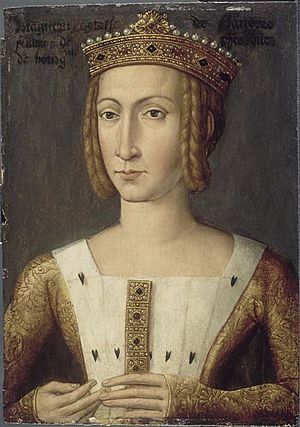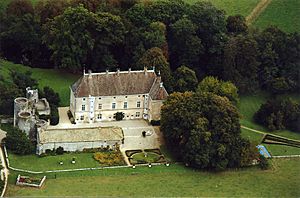Margaret III, Countess of Flanders facts for kids
Quick facts for kids Margaret III |
|
|---|---|

Margaret of Dampierre, Countess of Flanders
|
|
| Countess of Flanders | |
| Reign | 1384–1405 |
| Predecessor | Louis II |
| Successor | John the Fearless |
| Duchess consort of Burgundy | |
| Tenure | 14 May 1357 - 21 November 1361 |
| Tenure | 19 June 1369 - 27 April 1404 |
| Born | 13 April 1350 Male Castle, West Flanders, Belgium |
| Died | 16 March 1405 (aged 54) Arras, Artois, France. |
| Spouse |
|
| Issue |
|
| House | Dampierre |
| Father | Louis II, Count of Flanders |
| Mother | Margaret of Brabant |
Margaret III (born April 13, 1350 – died March 16 or 21, 1405) was a very important noblewoman in medieval Europe. She was the last Countess of Flanders from her family, the House of Dampierre. She also held many other titles, like Countess of Artois and Duchess of Burgundy.
Biography
Margaret was the only child of Louis II, Count of Flanders and Margaret of Brabant. This meant she was the only one who could inherit all their lands and titles.
In 1355, when she was just five years old, Margaret married Philip of Rouvres. He was also a very important noble, holding titles like Duke of Burgundy and Count of Artois. Sadly, Philip died in 1361 from a riding accident. They did not have any children together.
After Philip's death, the King of France, John II of France, took control of the Duchy of Burgundy. In 1364, King John gave the Duchy to his youngest son, Philip the Bold. Philip the Bold then married Margaret in 1369.
When Margaret's father, the Count of Flanders, died in 1384, Margaret and Philip inherited many lands. These included the counties of Artois, Burgundy, Flanders, Nevers, and Rethel.
Philip the Bold died in 1404, and Margaret passed away the next year. With her death, her family, the House of Dampierre, no longer ruled Flanders. Flanders then became part of Burgundy, ruled by her son, John the Fearless. Later, it came under the control of the House of Habsburg.
Children of Margaret and Philip
Margaret and Philip the Bold had several children:
- John I of Burgundy, who became Duke of Burgundy. He inherited Flanders, Artois, and Burgundy from his parents.
- Charles of Burgundy (1372–1373)
- Margaret of Burgundy (born 1374 – died 1441), who married William II, Duke of Bavaria.
- Louis of Burgundy (1377–1378)
- Catherine of Burgundy (born 1378 – died 1425), who married Leopold IV, Duke of Austria.
- Bonne of Burgundy (1379–1399)
- Mary of Burgundy (born 1380 – died 1422), who married Amadeus VIII, Duke of Savoy.
- Antoine of Burgundy, who became Duke of Brabant. He died in a famous battle called the Battle of Agincourt.
- Philip II, Count of Nevers and Rethel (1389–1415), who also died at the Battle of Agincourt.
Margaret's Legacy
Margaret III was the last ruler from the main line of the House of Dampierre. Her family, the Dampierres, were originally just counts of Flanders. But they became much more powerful by making smart marriage choices. They gained control of Nevers in 1280 and Rethel in 1328.
Through Margaret's grandmother, they also added Artois and Burgundy (also known as the "Franche Comté") to their lands in 1382. These lands became the main part of the powerful new state ruled by the House of Valois-Burgundy. This family, related to the French kings, used these lands to become very strong in the 15th century.
Margaret's oldest son, John the Fearless, inherited many of her titles. He became Count of Nevers in 1384, Duke of Burgundy in 1404, and Count of Burgundy, Artois, and Flanders when Margaret died. Her younger son, Anthony, inherited Brabant and Limburg in 1406.
Margaret's Residences
One of Margaret's favorite places to live was the Château de Germolles in Burgundy. Her husband, Philip the Bold, gave it to her in 1381. Margaret turned this castle into a beautiful country home.
The château was a large rectangular building surrounded by a moat (a deep, wide ditch filled with water). Inside, it had a courtyard. Margaret was very active and loved the countryside. She decided to use the estate to grow things and create a lovely environment. She even planted a big rose garden! The rose petals from her garden were sent to Flanders to be used to make rose water.
Today, the Château de Germolles is still mostly preserved. It is one of the best examples of royal homes in France from the end of the Middle Ages.
See also
 In Spanish: Margarita III de Flandes para niños
In Spanish: Margarita III de Flandes para niños



